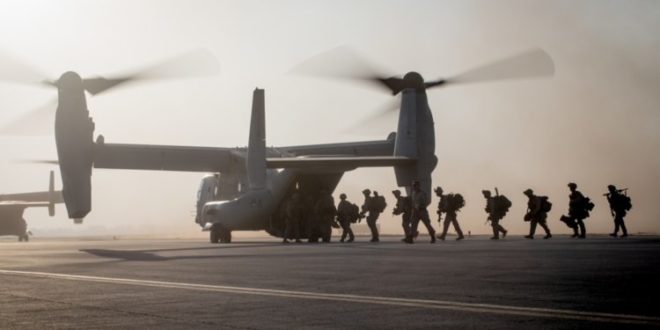Jordan’s lurid concerns over American pull-out
By Dr. Shehab Al Makahleh
Though Jordan is a strategic ally to the US, American President Donald Trump’s tweets on December 19, 2018 to withdraw his troops from Syria shocked Amman which has started consultations with Americans and Russians in the aftermath of this abrupt decision which has positioned Jordan amidst terrifying scenarios as the kingdom has more than 275 kilometers of borders with Syria. Amman has not been consulted in this regard, and the Jordanian government fears that the vacuum after the American troops’ withdrawal would have a spill-over on the Jordanian territory as a result.
For Jordan the American presence in Syria is not only to eliminate terrorist factions including Daesh, but rather it is against Iranian troops and its militias in Syria. Such factions and militias pose a major threat to Jordanian security and stability as Jordan has been working hand in hand with the international coalition to destroy Daesh and to distance Iran from Jordanian-Israeli borders by no less than 100 kilometers.

Jordan fears such a pull-out would create a vacuum from south-east of the Syrian Desert to south-west of the country including Quneitra and Dera’a (which are part of the de-escalation zones). Any vacuum in this area would encourage Daesh dormant cells to act and occupy lands bordering Jordan, posing a major threat to Jordanian security and military. In other words, this would drive terrorists to cross Syrian-Jordanian borders once skirmishes between Shi’ites and Sunnis break out in the region, causing the influx of new waves of refugees to the Jordanian borders.
Changing balance of power
On January 8th, US Secretary of State, Mike Pompeo, paid a visit to the region including Jordan. In a whirlwind tour that took him to eight countries in seven days, Pompeo held one key message: How to counter the major threats of all states in the Middle East region, how to collectively stand against the Iranian regime and means to nip in the bud any terrorist bids including those of Daesh.
He confirmed that that the American withdrawal from Syria will not have any negative consequences on Jordan. Pompeo assured allies in the region that the US will proceed further with its endeavours to counter Iranian presence. However, from a Jordanian viewpoint, this is a mere placebo. Though the US is determined to protect Jordan and the countries of the region from any external threat including an Iranian intrusion, Amman must have further assurances that such an American move would not backfire on the current situation in Jordan as the country is undergoing huge economic and security burdens.
This is can be internalised from the official statement of the Jordanian government represented by minister of foreign affairs Ayman Safadi when he said that everyone in the region finds Iran’s expansionist policies as a predicament.
“We all have problems with Iran’s expansionist policies in the region. All Arab countries, and I think the United States too, would want healthy relations based on the principle of non-intervention in the internal affairs of the other, and respecting the sovereignty of other countries,” the Jordanian minister added.
Jordan’s real concerns
The real concerns of Jordan come from two countries: Iraq and Syria at present. If a vacuum is created in Syria, the same scenario that had taken place in Iraq when the American troops pulled out would be looming if not already imminent. Thus, Jordanian forces which have been exhausted since 2003 on war on terrorism in Iraq and Syria can be targeted by terrorist factions which would benefit from this withdrawal of a major ally to Jordan to fill the gap, draining the power of Jordanian armed forces in an attrition war.
Post-withdrawal challenges
US bases are distributed in the north of Syria from the east of the Euphrates to the point of convergence of the Turkish-Syrian border at the Faysh Khabour crossing in the Zakho District in Dohuk governorate. It extends from south of Al-Hasakah in Al-Shaddadi to the east of Deir Al-Zour, from Al-Qaim to Al-Tanf area. The north of this region is attached to Turkey and the east with the Iraqi border. This area is deemed one of the most important regions in Syria because of oil and gas fields, agricultural land, water reservoirs and dams.
When American troops intervened in Syria, the main objective was to eliminate Daesh, which occupied 50 per cent of Syria in 2013. The American strategy at that time focused on supporting the Kurdish allies who formed the so-called Syrian Democratic Forces, launching air strikes to drain the capabilities of terrorist factions and carrying out qualitative operations against the group’s leaders.
On September 2018, the Americans in Syria were training about 40,000 Kurdish fighters to be able to guard the borders between Turkey and Iraq from the Syrian side. Jordanians have their own concerns about the fate of the refugees in Al Rukban Camp and about Daesh prisoners. What is of due concern to Jordan and poses high risk is the vacuum after the US troops pull out as Americans are deployed in 20 bases and sites in the north and east of Syria. The most important of these locations are Al Rumailan base in Al Hasakah, which includes an air base for military shipment, Kharab Ashk base near Ain al-Arab with a helipad, Tal Baidar which is special for training of paramilitary forces, Al-Shadadi base south of Al-Hasakah, where American special forces are deployed and Al-Tanf base in southeast of Syria near the Iraqi-Jordanian border.
Since American forces were working as a buffer zone to protect Jordan from any intrusion of any terrorist action into Jordanian territory, this withdrawal would turn into a nightmare to Jordanian security unless alternative actions are taken.
 Geostrategic Media Political Commentary, Analysis, Security, Defense
Geostrategic Media Political Commentary, Analysis, Security, Defense






You must be logged in to post a comment.